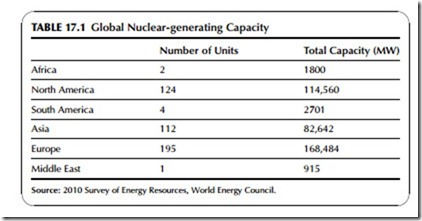GLOBAL NUCLEAR CAPACITY
At the end of 2009, according to figures compiled by the World Energy Coun- cil2 there were 437 operating nuclear reactors worldwide. These had a total generating capacity of 370 GW. A further 55 units were under construction; these had an aggregate capacity of 51 GW.
The global figures are broken down in Table 17.1 to show the distribution of current nuclear-generating capacity by region. Europe, with 195 units and 168 GW, has the greatest capacity. North America has 124 operating units with an aggregate generating capacity of 115 GW, while Asia has 112 units. Of the continents, only Australia and Antarctica have none.
Nationally, France produces around 75% of its electricity from nuclear power stations. Lithuania generates 76% from nuclear sources and Belgium 52%. In Asia, South Korea produces 35% of its power from nuclear units, while Japan before the Fukushima disaster, relied on nuclear power for 29% of its electricity. In all, 15 countries rely on nuclear plants for 25% or more of their electricity.
Net global nuclear generation in 2009 was 2558 TWh. Globally, nuclear power plants provide around 14% of total electricity generation, almost as much as hydropower. However, the overall global nuclear capacity has become
relatively static with new plants built in Asian countries such as China compensating for old plants removed from service in other parts of the world. Economically, nuclear power plants are perceived to be expensive to build. However, plants where the capital cost has been written off have proved extremely competitive generators of electricity, particularly in the United States.
How global capacity will develop in the future has become uncertain after the Fukushima Daiichi accident. The major source of nuclear growth over the past decade has been China and this continues to be the case, but there are indi- cations that ambitions here may be more limited than previously. Japan’s nuclear industry has suffered a damaging blow that may eventually force the country to retreat from nuclear fission. In Europe both France and the U.K. governments are supportive of nuclear power, but public support may be waning and the economics of construction in both countries are being questioned. Meanwhile the United States, which still has the largest nuclear fleet, in the world has taken the first steps in the second decade of the 21st century to build new nuclear capacity.
